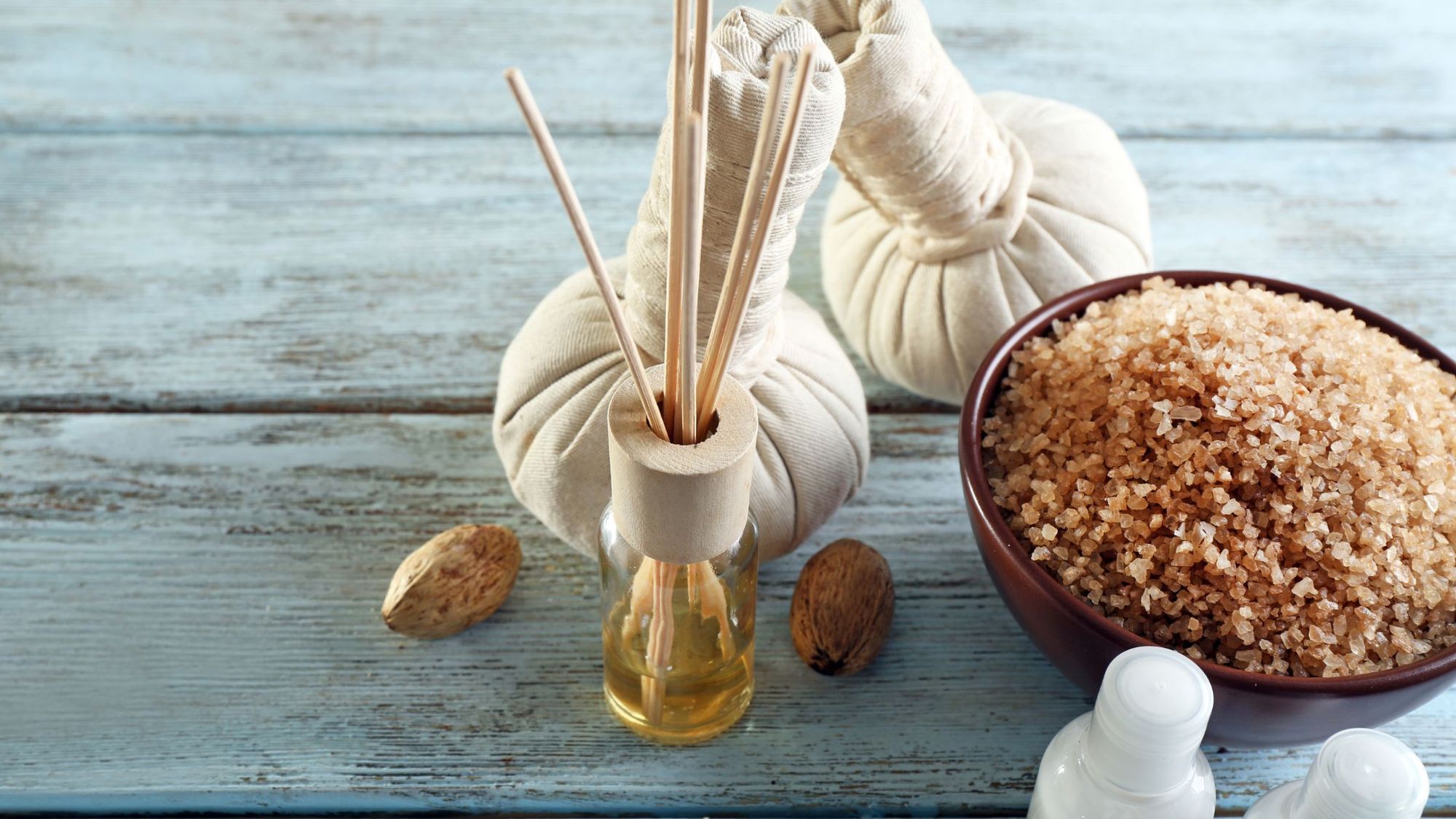
Human beings have explored the benefits of healing baths for centuries. Bathing isn’t just a hygiene practice. For many of us, it’s a way to pursue greater well-being, and it can be used as a natural remedy for many health concerns such as sore muscles and skin problems.
Over the years, we’ve discovered new kinds of “healing baths” capable of addressing various health issues.
From remedying skin conditions and reducing bloating, to relaxing tight muscles and improving sleep quality, healing baths are used as all sorts of different remedies.
Special “soaks” and unique bathing practices can help us overcome stress and anxiety as well. When we want to relieve tension after a long day at work, we soothe our senses with a nice warm bubble bath. When we need to recover quickly after a grueling workout routine, we use ice baths to stop inflammation in its tracks.
Learning about the unique healing properties of different kinds of healing baths can be a great way to enhance your self-care routine.
Let’s explore some of the most common healing baths, and how they work.
1. Oatmeal Baths
The ancient Romans used oatmeal extensively in their skincare routines.
Oats feature countless beneficial compounds, antioxidants, and vitamins. Adding oatmeal to healing baths can reduce inflammation, promote moisture retention, and even support the development of antioxidants in the body.
One specific form of oatmeal, “colloidal oatmeal,” is rich in vitamin E, ferulic acid, and avenanthramides. All these substances help combat inflammation and improve skin health, and they could even act as a remedy for psoriasis and eczema.
Oatmeal is also a fantastic buffering agent. It protects your skin from rapid moisture evaporation and helps you maintain a good PH balance. For people suffering from allergies with skin-based symptoms, experts suggest oatmeal can reduce the rate of histamine release by mast cells, leading to fewer rashes, swelling, and soreness.
People even use oatmeal to treat skin conditions such as chickenpox, diaper rash, and atopic dermatitis.

2. Sea Salt Baths
Centuries ago, humans relied heavily on salt water for bathing. Today, adding a little natural sea salt to your bath water could help you unlock some ancient benefits.
Sea salt is minimally processed, as it’s collected from evaporated seawater. Most sea salt contains several beneficial trace minerals, such as magnesium, zinc, calcium, iron, and potassium.
The minerals in sea salt baths are excellent for relieving stress, curing achy muscles, and soothing skin irritation. Dermatologists have even recommended sea salt baths to patients with dry skin conditions such as psoriasis and eczema.
One review also found sea salt baths beneficial in treating various rheumatic diseases.
Sea salt baths can also assist with boosting circulation and easing muscle cramps, alleviating stiffness and pain in joints, and even soothing achy legs and feet.

3. Ice Baths
Cold therapy is a powerful tool for people with muscle pain. That’s why many athletes and fitness enthusiasts end their workout routine with an ice bath.
Although dousing yourself in ice might not seem like the most relaxing way to spend an evening at home, “cryotherapy” has numerous unique benefits.
Immersing yourself in cold water reduces pain caused by sore and burning muscles recovering from a workout. Healing baths in ice can also support the central nervous system, paving the way for a good night’s sleep.
When you expose your body to ultra-cool temperatures, you also inhibit the natural inflammatory response your muscles have to pain. This can help you to recover and get back to the gym faster.
Cold stimulation can also help activate and train the vagus nerve. This nerve links to the parasympathetic nervous system, which controls all of our autonomous behaviors, like blinking, breathing, sleeping, and maintaining our heart rate.
Training your vagus nerve with cold therapy can reduce feelings of stress and improve sleeping patterns. However, people with diabetes might need to be cautious with ice baths.
They can affect your ability to maintain your core body temperature.
4. Hot Baths
A simple hot bath can be one of the most relaxing ways to ease your mind and body. Research suggests that hot baths can help to stimulate recovery after a workout session. They also improve blood flow and circulation, which promotes rapid healing.
Heat and water therapies such as hot baths and saunas have been the subject of scientific study for many years. Researchers have revealed that heat therapy can improve circulation and vascular function, reduce blood pressure, and even improve sleep quality.
When you’re sitting in a hot bath, your core temperature rises. When you step out of the tub, the slow temperature drop helps signal to the body that it’s time for rest. Hot baths are also wonderful for tackling stress and anxiety, as they naturally give us a sense of tranquility and peace.
5. Epsom Salt Baths
Epsom salt is an ingredient used in various bath soaks today. It’s advertised as a tool for treating minor aches and pains, thanks to its unique ingredients. The two core ingredients of Epsom salt are sulfate and magnesium; a combination believed to stimulate detoxification pathways.
Magnesium is a powerful natural substance that assists with a range of bodily functions, while sulfate can help with strengthening the digestive tract and releasing toxins.
While there’s limited scientific research into the benefits of Epsom salts, advocates believe they can help with various skin conditions and issues.
Epsom salts can soften rough and dry skin by exfoliating a flaky epidermis. Healing baths with Epsom salts can also remedy some of the pains caused by gout and arthritis.
Some people also believe healthy magnesium levels can assist with boosting brain neurotransmitters crucial for inducing sleep and reducing stress.
6. Milk Baths
In some cases, as long as you don’t have a milk allergy, adding milk in liquid or powdered forms to warm water can be beneficial for various skin conditions. Milk baths can replenish lost moisture in people with dry skin, thanks to a mixture of proteins, fats, minerals, vitamins, and lactic acid.
In one study into skincare for women over 65, researchers found milk baths provided relief from itchy skin. This means milk baths could help with tackling issues of eczema and psoriasis and may be suitable for tackling the symptoms associated with poison ivy.
Some people also believe the fat, amino acids, proteins, and vitamins found in milk can be soothing for sunburned skin.
7. Float Tank (Sensory Deprivation Tank Baths)
Though float tanks aren’t baths in a traditional sense, they are another way of immersing yourself in water to gain various benefits.
The water in most sensory deprivation tasks includes sea salt or Epsom salt, to improve buoyancy so that you can float.
Sensory deprivation tanks are typically used for restricted environmental stimulation therapy (REST). They cut the user off from all outside distractions, and allow them to focus on mindfulness.
One study found a one-hour session in a sensory deprivation tank reduced anxiety and improved participant moods.
Sensory deprivation tanks could also be beneficial for tackling chronic pain. Some researchers believe these unique healing baths can soothe tension headaches and muscle pain. They may also help the body to “reconfigure” itself after being exposed to shock.
8. Sound Baths
Healing baths don’t always require users to immerse themselves in water.
Sometimes, you can achieve amazing benefits by drenching your body in sound waves.
A sound bath involves covering your body with waves of soothing, echoing sound, created by traditional percussion and wind instruments.
Some people believe this can help with stress, fatigue, and even the symptoms of depression. Since stress is commonly associated with other conditions like diabetes and heart disease, sound baths could be a good preventative health strategy.
While research into the benefits of sound baths is limited, various studies have indicated they may assist with improving mood and releasing tension. One report found a meditation session with a “sound bath” led participants to feel less stress, anxiety, and other negative moods.
Soothing Your Mind and Body with Healing Baths
There are various healing baths you can experiment with if you want to improve your physical and mental health. Whether you’re trying to minimize muscle cramps and soreness or looking for ways to reduce stress, there are countless options.
However, before you start experimenting with healing baths it’s important to understand yourself and your body’s needs. Some bath types may not be suitable for you if you’re sensitive to specific ingredients, or have a pre-existing medical condition. A CircleDNA test could help you to identify which healing baths to try and which to avoid.
Furthermore, your genetic skin reports from CircleDNA could provide you with more information about any genetic skin conditions you might have, and you could research which types of healing baths could help soothe those skin problems.
Resources:
- NCBI: Anti-inflammatory activities of colloidal oatmeal (Avena sativa) contribute to the effectiveness of oats in treatment of itch associated with dry, irritated skin. https://pubmed.ncbi.nlm.nih.gov/25607907/
- Science Direct: Scientific Evidence of the Therapeutic Effects of Dead Sea Treatments: A Systematic Review
https://www.sciencedirect.com/science/article/abs/pii/S0049017212000303?via%3Dihub - NCBI: Effects of Cold Stimulation on Cardiac-Vagal Activation in Healthy Participants: Randomized Controlled Trial. https://www.ncbi.nlm.nih.gov/pmc/articles/PMC6334714/
- Journals: Acute and chronic effects of hot water immersion on inflammation and metabolism in sedentary, overweight adults. https://journals.physiology.org/doi/full/10.1152/japplphysiol.00407.2018
- Derm: Dermatologic Problems of Older Women. https://www.derm.theclinics.com/article/S0733-8635(06)00013-1/fulltext
- NCBI: Examining the short-term anxiolytic and antidepressant effect of Floatation-REST. https://www.ncbi.nlm.nih.gov/pmc/articles/PMC5796691/
- NCBI: Effects of Singing Bowl Sound Meditation on Mood, Tension, and Well-being: An Observational Study. https://www.ncbi.nlm.nih.gov/pmc/articles/PMC5871151/






